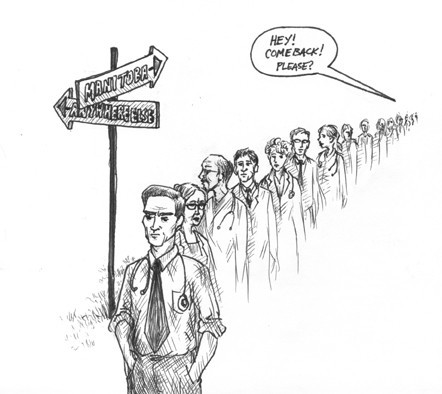Is anybody here a doctor (or nurse)?
Province spends millions to retain and attract Manitoba doctors and nurses
The Manitoba government recently announced an investment of over $2.1 million to fund a large, multi-tiered strategy to recruit and retain Manitoba doctors. The investment has caused many to speculate whether there is a shortage of medical practitioners in Manitoba and whether the province is doing enough.
The scarcity of physicians is widespread but far more noticeable in rural and remote areas of the province. Manitobans frequently experience difficulties finding a family doctor, said a registered nurse who requested anonymity.
The $2.1 million fund, announced in late August, is divided into several areas. Those areas include a $90,000 repatriation fund that would seek out and encourage Manitoba medical students, studying in other provinces or abroad, to return to Manitoba.
The new strategy would also invest $500,000 for a physician resettlement fund to create more incentives, covering moving and other expenses, for doctors to practice in rural Manitoba.
There are also questions as to whether nurses are joining physicians in seeking employment elsewhere.
Human resources systems for registered nurses are not integrated with the records kept by employers, so it is difficult to track whether or not Manitoba nursing graduates are leaving the province, or leaving the profession entirely. What is known is that the province is unable to compel nurses to stay in the province, and further unable to control where they seek employment. As a result, there are continued shortages in rural areas, said the nurse.
The announcement of a physician recruitment strategy comes while the Manitoba government invests $134,000 in a Medical Careers Exploration program (as part of the government’s Bright Futures program) that would see youth at the largely aboriginal Children of the Earth High School learn more about the possibilities of a medical career.
“We have adopted many different programs because it is important for aboriginal students to go into medical practice in order to assist their people at that [medical] level,” said advanced education minister Diane McGifford.
Students who were once ambivalent about a post-secondary education are now interested in university, particularly in the medical field, she added.
“If you can get high school students interested in medical practices early on then they are more likely to commit to a medical career in Manitoba,” said Brenda Stutski, director of nursing innovation and research at the Health Sciences Centre. “And the programs in place for aboriginal students should be made more available for other students as well.”
A recent national survey conducted by Student Awards Inc., a free service to help students find scholarships and bursaries, found that this year 91 per cent of nursing students are starting out with less than $5,000 devoted to their education.
“We do a lot of internship placement for aboriginal students, but I think nursing students would benefit from good paying summer jobs as well,” said Stutski.
“What prevails in one province doesn’t necessarily prevail in another,” said McGifford. Manitoba post-secondary education is among the most subsidized in the country and any kind of national survey can skew numbers, she said.
Published in Volume 64, Number 6 of The Uniter (October 8, 2009)








